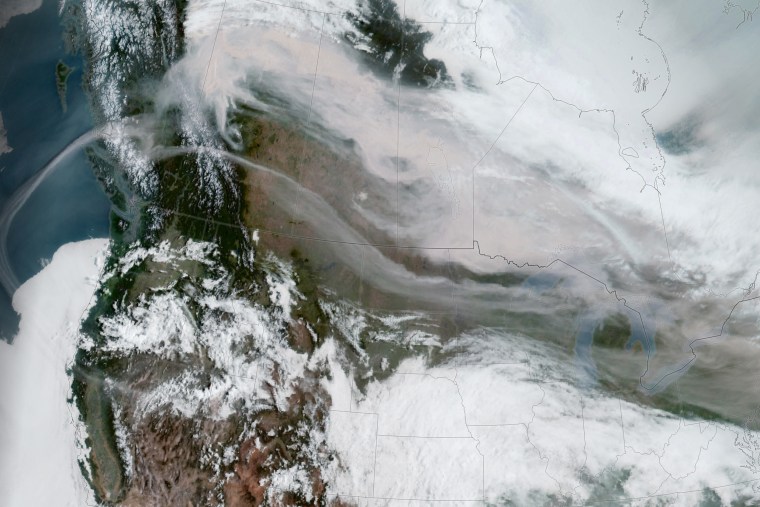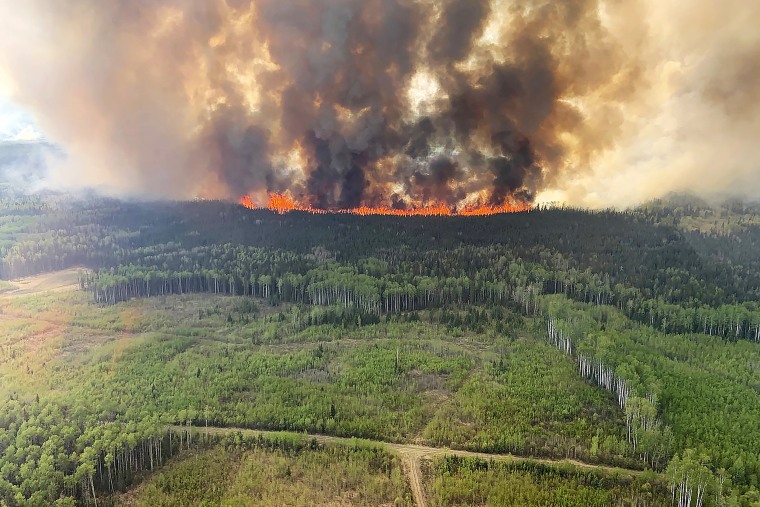High temperature records fell by the dozen this week as western Canada continued to suffer in a prolonged, scorching heat wave.
About 90 wildfires, spurred on by unusually high temperatures, continue to burn in Alberta. Smoke blanketed the province in unhealthy air and dipped across the border into the U.S., according to satellite photos.
The heat wave pattern — described as an “omega block” by meteorologists — resembles in some ways the record-breaking heat event in Canada and the U.S. Pacific Northwest in June 2021, which killed hundreds of people. The intense spring wildfires in Alberta are reminiscent of the 2016 Fort McMurray wildfire, which is considered one of Canada’s costliest natural disasters.
“This is a very unusual pattern. We often don’t see these types of patterns set up this early in the year. We see these patterns in the summer,” said Terri Lang, a warning preparedness meteorologist for Environment and Climate Change Canada.
It can take months for scientists to determine whether a particular weather anomaly is the result of climate change and the heating of the atmosphere by the burning of fossil fuels. But Lang said the events fit with what climate scientists have predicted for western Canada.

“It is consistent with what the science of climate change is telling us — that the climate’s warming, that temperatures are getting warmer and drier early on in the year and that warming temperatures lead to more forest fires,” she said.
The early-season heat and wildfires — which had displaced nearly 20,000 people as of Tuesday and threatened some oil extraction operations — set the stage for a long, smoky summer in western Canada, where seasonal and long-term forecasts predict more heat. The events show how extreme weather, made more common by climate change, can disrupt lives and shift economies.
The “omega block” pattern was established in late April and early May, Lang said. The pattern — a massive block of high pressure that resembles the Greek letter it is named for — has continued to sit over the region for weeks, sending temperatures soaring into record-breaking territory in early May.
Daily temperature records have been broken with regularity in Alberta and other provinces since the beginning of the month.
Weather stations in seven Alberta locations eclipsed daily highs Tuesday. British Columbia, Saskatchewan and other provinces also set records this week.

Lytton, British Columbia — which had Canada’s all-time recorded high of 121 degrees Fahrenheit during the June 2021 heat wave and then burned to the ground a day later — was one of several communities to set new daily records this week.
Temperatures last weekend spiked to record-setting levels in the U.S. Pacific Northwest, at the edge of the high pressure pattern, where Seattle recorded highs in the upper 80s and set new temperature highs four days in a row, according to the National Weather Service. The bayside town of Hoquiam, Washington, reached 91 degrees, a stunning mark for an area that usually has moderate temperatures because of its proximity to the Pacific Ocean.
“Last weekend was definitely anomalous, especially for May,” said Kayla Mazurkiewicz, a meteorologist at the National Weather Service in Seattle, who noted that the high pressure system has remained centered over western Canada. “That pattern was directly over that area. That’s why they’ve gotten the brunt of it.”
The heat wave in June 2021 was also caused by a ridge of high pressure. It contributed to more than 860 deaths in British Columbia, Washington and Oregon, according to research published in Nature Communications.
Climate researchers determined the anomalous heat would be “virtually impossible” if not for the impacts of climate change.
Nathan Gillett, a research scientist with Environment and Climate Change Canada who contributed to that research, said what’s happening this month is an “extreme event” but less so in comparison to 2021. Gillett said researchers were considering a new, detailed climate attribution study of the recent heat wave.
“The risk of these kinds of heat waves everywhere has been induced by human-caused climate change,” Gillett said.
The hot weather has made fire danger in Alberta extreme. More than 2,500 wildland firefighters are working in the province, which reported that 19,576 had been evacuated from the areas where about 90 fires were burning.
The wildfires could affect global energy prices. Wildfires forced some Canadian shale operators to halt work this month, according to Rystad Energy, an independent energy research firm. Rystad estimated that at least 240,000 barrels of oil could not be pumped each day because of outages. Production of 2.7 million barrels of oil each day is within areas in “very high” or “extreme” wildfire danger rating zones, according to a special market update from company Vice President Thomas Liles.

The fires are causing air quality problems. In Calgary on Wednesday, the air quality was rated 10+, meaning it topped the risk scale used by Canadian authorities.
NASA Earth Observatory published satellite imagery showing that more than 1,800 square miles of land had burned in Alberta, British Columbia and Saskatchewan as of Tuesday. The smoke was spreading into parts of North America, including the Upper Midwest. The Minnesota Pollution Control Agency issued an air quality alert for Wednesday and Thursday, forecasting that the air would be “unhealthy for everybody” in northern areas of the state.
In the meantime, the heat was scrambling ecosystems in other areas of Canada. In British Columbia, the warmth prompted a rapid melt-out of mountain snow. That left officials dealing with flood and fire evacuations at the same time.
And “in the southern Northwest Territories, there’s still ice on the lakes up there, and yet they’re dealing with forest fires and towns burning down,” Lang said.
The weather is predicted to remain hot and dry in long-term forecasts, Lang and Gillett said.
“We don’t see an end in sight,” Lang said.